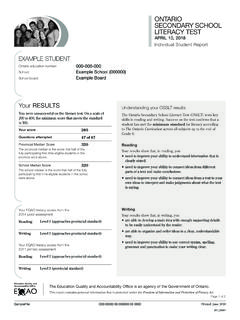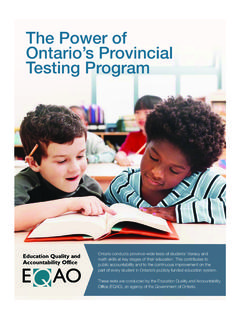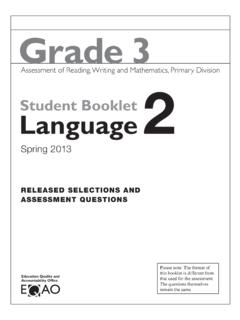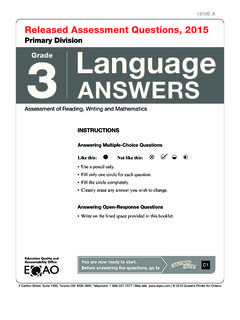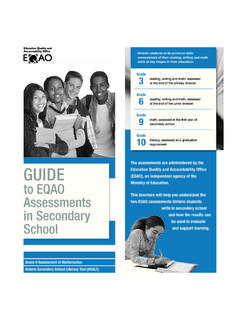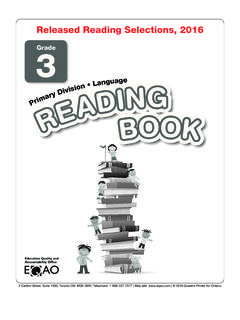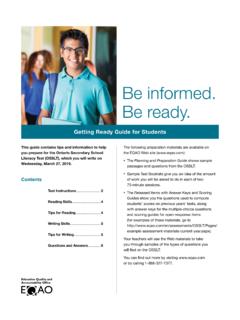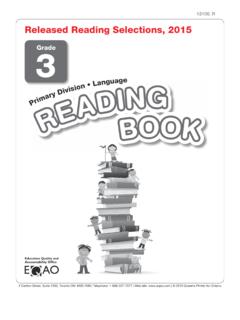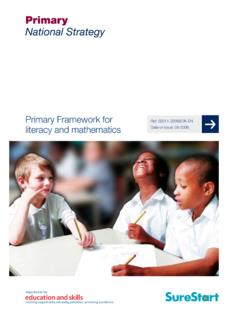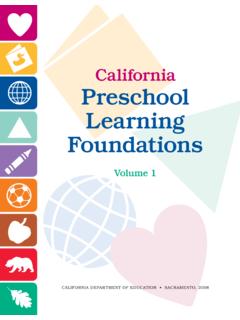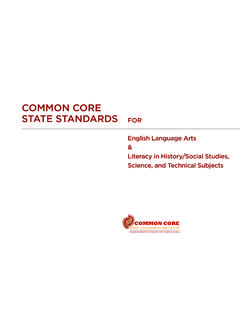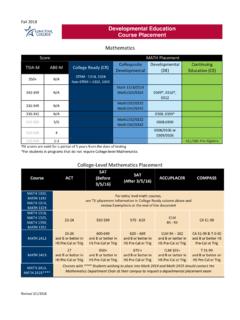Transcription of Framework Ontario Secondary School Literacy Test
1 Ontario Secondary School Literacy TestFrameworkDecember 2007 EditionFrameworkOntario Secondary School Literacy TestDecember 2007 Edition1 FrameworkOntario Secondary School Literacy TestContentsIntroduction2 CHAPTER 1: About EQAO and Provincial Assessments 3 CHAPTER 2: The OSSLT6 CHAPTER 3: What Is Assessed by the OSSLT 10 CHAPTER 4: The Assessment Process16 CHAPTER 5: Curriculum Connections18 CHAPTER 6: How the Test Is Scored28 CHAPTER 7: Maintaining Comparability32 References33 December 2007 Edition:What s new in this frameworkSee page 2 to learn about changes in the December 2007 Framework provides a detailed description of the Ontario Secondar ySchool Literacy Test (OSSLT), which isconducted each year in Ontario .
2 It alsodescribes how the OSSLT aligns with the expectations in The is this Framework for?This Framework has been prepared for educators; parents and members of the general is in the Framework ?In this Framework , you will findChapter 1:a brief introduction to EQAO,large-scale assessments in Ontario and theOSSLT, and information on the differencesbetween large-scale and classroom 2:information about the purposeand benefits of the OSSLT, a description ofhow results are reported as well as infor-mation about how the OSSLT aligns withnational and international 3:an introduction to the OSSLT,a description of how it aligns with TheOntario Curriculumand with currentresearch and a delineation of what 4.
3 Discussions of the assessmentprocess, the content of the OSSLT, accom-modations and special provisions, howEQAO determines whether a student haspassed and the meaning of Ontario s achieve-ment 5:information on how EQAO assessments are aligned with 6: information on how readingand writing questions are 7: a discussion of how EQAO ensures that its assessments are comparablefrom year to year. 2 FrameworkOntario Secondary School Literacy TestIntroductionWhat s New in the December 2007 EditionThe December 2007 edition of the frame-work has been reorganized and rewrittento improve clarity and hasalso been redesigned to enhance thepresentation of information in both textand chart edition carries over a number of changes in the December2006 edition and make some new ones,as described below: There were minor adjustments to thereading and writing charts showing thenumber of items and raw score pointdistributions.
4 The reading and writing curriculumconnection charts have been updated asa result of the release of the revisedOntario Curriculum, Grades 1 8: Language(revised 2006) and Grades 9 and 10:English(revised 2007).3 FrameworkOntario Secondary School Literacy TestIn This Chapter What is EQAO? What is assessment? What assessments does EQAO conduct? What is the OSSLT?Insight:Differences betweenlarge-scale and classroomassessmentWhat is EQAO?The Education Quality andAccountability Office (EQAO)is an arm s-length agency of theprovincial government that measures theachievement of students across Ontario inreading, writing and mathematics, andreports the results to parents, educatorsand government.
5 EQAO assessments arebased on the expectations in The results are reported at the provincial, School board and schoollevels. They are used by the Ministr y of Education, district School boards andschools to improve learning, teachingand student achievement. An IndividualStudent Report is also provided byEQAO for each student who writes anEQAO is assessment?Assessment is an important part ofteaching and learning. For example,teachers use assessment in the classroomto gauge the skills and knowledge oftheir students. They use this informationto plan their teaching and identify individual students who may need CHAPTER 1:About EQAOand ProvincialAssessmentsWHERE TO LEARN MOREFor more information and valuableresources for parents and educators,visit the EQAO Web :Differences between large-scale and classroom assessmentadditional help.
6 A traditional test is one kindof assessment, but student progress can bemeasured in many other ways. Reviewing aportfolio of student work is one assessments, like those conducted by EQAO, measure studentachievement across the province at criticaltimes in students School Secondary School Literacy TestEQAO s Large-Scale AssessmentsClassroom AssessmentThe purpose of EQAO s large-scale assessments is to provide comparable year-to-year data to give the public information on student s large-scale assessments providereliable, objective and high-quality data thatcan inform School boards improvementplanning and target s large-scale assessment materials are created and scored at a distance.
7 The assessment scorers do not knowthe students s large-scale assessments are summative; they present a snapshot of student achievement or learning at the time the assessment is s large-scale assessments require students to demonstrate their knowledgeand skills independently on standardizedtasks and under standardized conditions,although some accommodations are allowedfor students with special education purposes of classroom assessment areto improve student learning (using modelssuch as Ministry exemplars to assess thequality of work), to report regularly onstudent achievement and to provide timely,constructive feedback for assessments encourage studentsto engage in self-evaluation and personalgoal also provide parents with information on strengths and weaknesses that can be used to encourage assessment materials are usuallycreated and marked by a teacher whoknows the students assessments are conducted in aninstructional context and include diagnostic,formative and summative administered at regular intervals wide variety of supports (reminders,clarification)
8 Are often available to addressstudents special education needs and s large-scale assessments measureachievement against expectations from theprescribed curriculum and contain tasks anditems that sample from and represent thecurriculum for the domain s large-scale assessments provide thesame (in a given year) or psychometricallycomparable items (from year to year) for order for students results on EQAO slarge-scale assessments to be comparableacross the province, the assessments mustbe administered, scored and reported on ina consistent and standardized EQAO s large-scale assessments, allscorers use the same scoring guides and aretrained and monitoredto ensure objectivityand assessments measure expectationsfrom the curriculum and contain tasks anditems that represent expectations.
9 Topicsand themes that have been questions are written in language used regularly in the classroom by the assessments can provide modifieditems or tasks tailored to the special educationneeds of individuals or groups of of classroom assessments across the province are not always comparable,because of the variation in administrationprocedures and time allowed, amount ofteacher support, modification of items tosuit student needs and teacher autonomy in marking of classroom assessments ismore subjective and is often influenced bycontextual information about the students thatis available to the use theachievement charts in the curriculum policydocuments to guide assessment Secondary School Literacy TestWhat assessments does EQAO conduct?
10 EQAO conducts four provincial assessmentseach year. These are theAssessment of Reading, Writing andMathematics, Primar y Division (Grades 1 3); the Assessment of Reading, Writing andMathematics, Junior Division (Grades 4 6); the Grade 9 Assessment of Mathematicsand the is the OSSLT?The OSSLT, which is the subject of thisframework, assesses whether students have the Literacy (reading and writing) skillsneeded to meet the Literacy requirement forthe Ontario Secondar y School Diploma(OSSD). The remaining sections of thisframework describe the OSSLT in greaterdetail. In This Chapter What is the purpose of the OSSLT?
